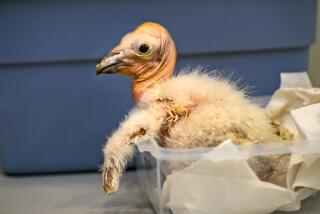Peregrine Falcon Reintroduced Into East : Environment: The peregrine falcon is flourishing again east of the Mississippi River after becoming extinct from the ravages of DDT in the 1950s and 1960s.
SOMEWHERE ON THE VIRGINIA-WEST VIRGINIA BORDER — As the sun broke through the morning fog in the western Shenandoah Valley, six down-covered peregrine falcons chirped, squawked and shrieked as they adjusted to their new man-made nest atop a 30-foot stone tower.
Until last year, those sounds had not been heard in Virginia for more than four decades.
“It sure makes you feel good to reintroduce a species,” said Robert Glasgow, wildlife biologist with the George Washington National Forest, as he helped place the young birds in their new home. “They’re a beautiful animal.”
With the help of the U.S. Forest Service, the Virginia Department of Game and Inland Fisheries and a private organization, the peregrine falcon is slowly making a comeback east of the Mississippi River after becoming extinct there in the 1950s and 1960s.
So far, 30 peregrines have been brought to this densely forested valley.
“They’re a nifty bird,” Glasgow said. “Once you see them, even if you’re not a bird lover, you’ll be impressed.”
The sleek blue-gray peregrine falcon, with a wingspan of about 40 inches, has long been a favorite with falconers because of its acrobatic flying and its hunting abilities. It is thought to be the world’s fastest creature, hitting speeds of 200 m.p.h.
“They literally drop out of the sky at amazing speeds, with their claws clenched like fists, and break the backs of their prey and then they swoop under and catch it before (it hits) the ground,” Glasgow said. The falcons feed mostly on pigeons, blackbirds and other small birds, he said.
In the 1950s, peregrines started to vanish when the pesticide DDT contaminated the falcon food chain. The chemical caused the bird to lay thin-shelled eggs that cracked during incubation.
Glasgow said excessive collection of eggs by oologists and falconers capturing the young contributed to the bird’s disappearance.
Because of the animal’s popularity, project officials did not publicly disclose the exact site of the baby peregrines’ nest.
The falcons, which arrived from the Peregrine Fund, a nonprofit organization in Boise, Ida., were placed in a 4-by-5-foot plywood box with bars on one side.
For six weeks, two “hack site attendants” from the College of William and Mary will camp near the nest to observe and take care of the falcons.
“I’m excited about doing this,” said Chris Dassler, 23, one of the caretakers.
“See how excited we are in six or eight weeks,” joked his companion, Amy Reid, 23.
Dassler and Reid will feed the peregrines dead quails dropped through a hole in the box once a day, Mitchell A. Byrd, professor of zoology at the College of William and Mary, said.
They will try to remain as unobtrusive as possible to “avoid having the birds associate human contact with food,” Byrd said.
In about two weeks, the young birds will hone their flying skills. As they soar through the sky, they will practice “dive-bombing on other birds,” Glasgow said.
“They’ll even hit butterflies and send wings going in four different directions.”
Dassler agreed. Pointing to some tiny birds on the horizon, he said: “All these poor little birds may not be here much longer.”
The attendants leave the area when the birds have learned to hunt on their own.
Marty Gilroy, eastern coordinator of the Peregrine Fund, said the reintroduction program is a slow but worthwhile process. “Without it, there would never be a peregrine in the East again.”
Peregrine falcons in the western part of the country disappeared more slowly than the ones in the East. Gilroy estimates that there are about 800 peregrine falcons nationwide.
The Peregrine Fund has released more than 2,600 falcons into 22 states as part of its reintroduction program. But young peregrines have a naturally high mortality rate, Gilroy said. He predicted that four of the six birds will not reach the mating age of 3 years.
One of the main predators of the young peregrines is the great horned owl, Byrd said.
Project workers survey the proposed sites of nests very carefully to avoid the owl.
Twelve baby peregrines were brought into another nest across the valley. “They’re just beginning to fly now,” Glasgow said. The site being used for the six new peregrines is above 4,000 feet, which is thought to be above the owl’s hunting territory.
More to Read
Sign up for Essential California
The most important California stories and recommendations in your inbox every morning.
You may occasionally receive promotional content from the Los Angeles Times.










